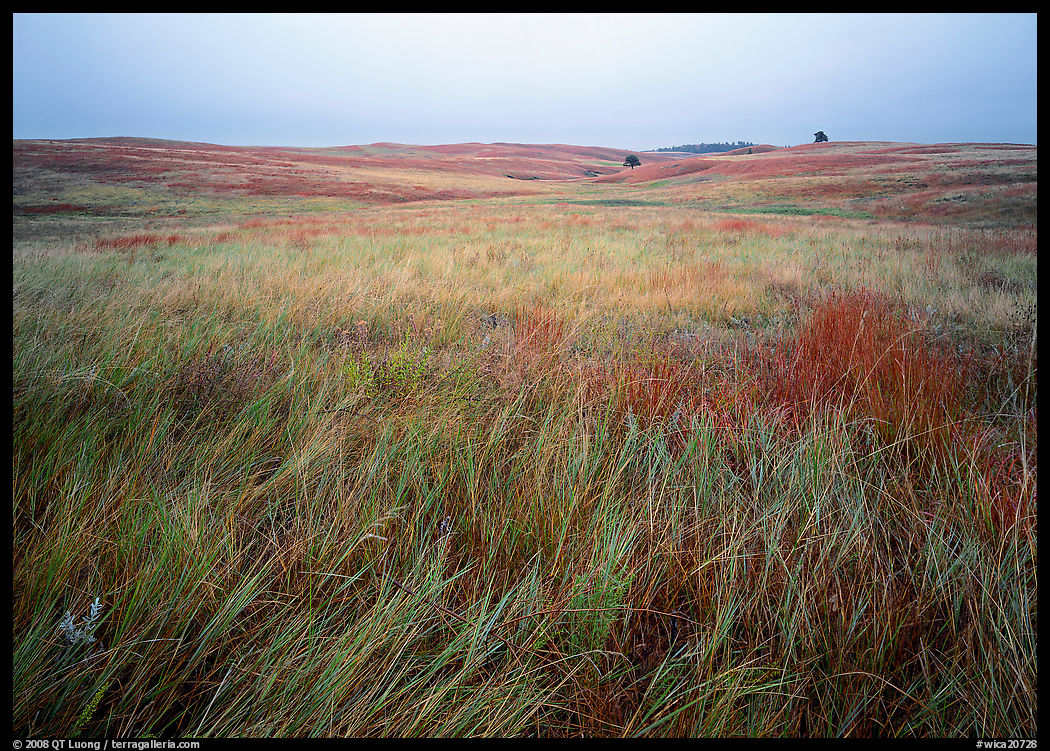Two photographs: dull light v. dramatic light on the grasslands
4 Comments
Large and distant subjects generally need strong shadows to define their shape. For photographing grand landscapes, there may be nothing more discouraging than an overcast day, confirming the adage “dull light, dull photos”. But is it true? This article compares two photographs of an understated subject in two extreme light situations: overcast and sunrise.
The centerpiece of Wind Cave National Park in South Dakota is the cave, but for photographers, the main attraction may well be the extensive grassland that covers more than two-thirds of the park’s surface, as it is one of the last remaining sections of the original prairie that once covered a huge area of mid-America. This section of prairie would not have been preserved if it weren’t for the network of caves that lie underneath. At Bison Flats, just south of the junction with the visitor center road, a very open prairie lies along Hwy 385. Ecological importance and visual appeal can diverge, and the prairie is not what you’d call a spectacular subject.
During my first visit there, it was raining all the time. Some say that the sweetest sound is that of raindrops falling on the tent since it means that one can stay in the sleeping bag without regret. I resisted the temptation and got to work at sunrise time. It was clear that the clouds would not clear anytime soon and there would not be even a hint of sunrise color, but some gradations were present in the sky, as opposed to a uniformly overcast sky. Every small detail like that counts, and I considered myself vindicated for not sleeping in.
The grasses exuded a fresh, damp smell that beckoned me to linger a bit longer and take a more attentive look. I identified a diverse blend of tall and short grass species. Even in those dreadful conditions, the allure of the grasses inspired me to pull out the camera and make a large-format photograph. From a distance, the grasses all look the same, but I recognized patches with different color characteristics and looked for local color contrast. I used a wide-angle lens and positioned the camera so that the grasses arranged themselves in a flowing way. Combined with a low viewpoint, the wide-angle lens added depth to the image by creating perspective with the strong decrease in size of the receding blades of grass. It made the background elements very small, but they were still resolved enough, as this type of flat subject is perfectly focussed from front to back with a bit of tilt. The distant trees helped provide a crucial focal point and counterweight.

To see how this photograph works, let us compare to another version of the same scene. Another year, I returned in better weather, hoping for less flat light. I headed to the same location for sunrise, when the light would be at its most dramatic, maybe a necessity for such an understated subject. Using the same focal length and a similar viewpoint and composition, I looked for a position that would utilize the dramatic play of light and shadow the best. A spot with prominent shadows in the foreground helped highlight the texture of the prairie as the low sun grazed it laterally, making each individual blade of grass stand out.

What makes the blades of grass stand out in that second photograph is their shape, detached against darker shaded areas. The differences in color within the grass are not visible at all, as they are overwhelmed by the warm light of sunrise. Instead, the photograph relies on the color contrast of two large image areas, the warm prairie and the cool sky. In the first photograph, despite the lack of shadows, the blades of grass are still well-differentiated from each other thanks to the color contrast between the light greens and the rust colors. The overcast light revealed those, and even more subtle color differences, making this photograph more intricate. Overcast light doesn’t highlight nor define anything, but it also doesn’t hide anything, so in the end, it offered more possibilities.
The two images of the same scene are clearly different in mood. Although I thought the overcast image may be richer, in the sense that it rewards an extended viewing with more to see, for Treasured Lands, I chose the sunlit version for its drama that makes it more immediately appealing, and also because it fit better with other images. In the book he and Kate Jordahl produced on the occasion of a gallery exhibit, curator Geir Jordahl chose the overcast image. Which image do you prefer, and why? (if you do not see poll question, click here)


The sunrise image has more drama in it – the sky contrasting with the warm foreground. The foreground blades of grass appear to be singing as they are kissed by the rising sun…. Beautiful image!
I like the overcast one as it is less abrupt and ‘plays’ it’s details with the existing light…takes time to show off a palette of colors.
It was a very hard choice and I am not really sure that I prefer one over the other. I like the overcast one for the very natural look to it. It even seems more expansive than the sunlit one which I like for the color and drama. They are both beautiful in their own right.
Mary, Victor, Shelly, thank you for weighing in. A difficult choice!